

vSphere Storage vMotion: Storage Management & Virtual Machine Migration. Untitled. As an architect, I talk to many vendors and customers, and often the conversation is about what makes one storage vendor better than another for VMware.
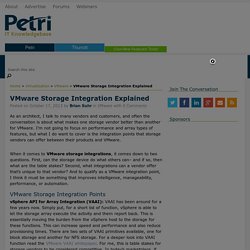
I’m not going to focus on performance and array types of features, but what I do want to cover is the integration points that storage vendors can offer between their products and VMware. When it comes to VMware storage integrations, it comes down to two questions. First, can the storage device do what others can– and if so, then what are the table stakes? Second, what integrations can a vendor offer that’s unique to that vendor? And to qualify as a VMware integration point, I think it must be something that improves intelligence, manageability, performance, or automation. vSphere API for Array Integration (VAAI): VAAI has been around for a few years now. vSphere APIs for Storage Awareness (VASA): VASA was released with vSphere 5.0, and it’s there to identify storage capabilities. Tagged API, storage, VAAI, VASA, vCenter, vSphere. VMware vSphere: Storage Profiles. VMware Storage Integration & Top Storage Vendors.
Research done in collaboration with Stuart Miniman and Nick Allen Introduction In April 2011 Wikibon ran a survey looking at the area of storage and VMware.

The results showed that EMC and NetApp had a clear lead in the number of respondents that selected them as the best VMware storage and as the primary VMware storage vendor. Wikibon has further analyzed the results of the survey, including a detailed analysis of the degree of integration. The findings of this analysis were similar to the first report, that EMC and NetApp were the leading storage vendors in integration of storage and VMware. Figure 1 – Relative Positioning of VMware Storage Integration by VendorSource: Wikibon Survey April 2011, n=361, and detailed analysis of vendor implementations.
Wikibon believes that practitioners can use the methodology in this report to help position the importance of integration features for their own VMware storage decisions and to help decide which vendors to include in RFPs. Conclusions. VMware's Virtual SAN Threatens Traditional Data Storage Models. VMware has launched the final part of its software defined data center puzzle: a virtual SAN product called Virtual SAN.
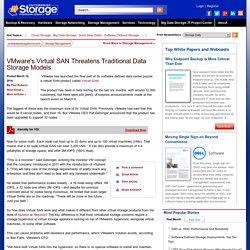
The product has been in beta testing for the last six months, with around 12,000 customers, but there were still plenty of surprise announcements made at the launch event on March 6. The biggest of these was the maximum size of its Virtual SAN. Previously VMware had said that this would be 8 server nodes, and then 16. But VMware CEO Pat Gelsinger announced that the product has been upgraded to support 32 nodes. Now for some math. "This is a monster," said Gelsinger, echoing the monster VM concept that the company introduced in 2011 with the introduction of vSphere 5. He added that performance scales linearly - a 16 node setup offers 1M IOPS, a 32 node one offers 2M IOPS - and despite his previous comment about 32 nodes being monstrous, he hinted that even larger Virtual SANs are on the roadmap: "There will be more in the future.
It turns out that there's two ways. VMware Storage and Software-defined Storage (SDS) Solutions Blog Posts. Oregon State University, a public institution with more than 26,000 students and growing VDI workloads wanted a high performance storage tier for their VDI environment.
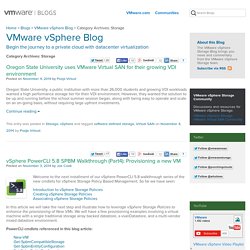
However, they wanted the solution to be up and running before the school summer session began, along with being easy to operate and scale on an on-going basis, without requiring large upfront investments. Continue reading Welcome to the next installment of our vSphere PowerCLI 5.8 walkthrough series of the new cmdlets for vSphere Storage Policy Based Management. So far we have seen: VMware vSphere: Storage Virtualization & Storage Management. VMworld 2014 VMware vCloud Air and ViPR Object Storage. This one is short and sweet!
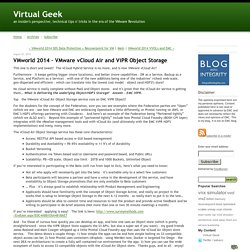
The vCloud Hybrid Service is no more, and is now VMware vCloud Air! Furthermore – it keeps getting bigger (more locations), and better (more capabilities – DR as a Service, Backup as a Service, and Platform as a Service) – with one of the new additions being one of the industries’ richest web-scale, geo-dispersed and efficient - which can translate into the lowest cost model – object (and HDFS!) Store! No cloud service is really complete without PaaS and Object stores – and it’s great that the vCloud Air service is getting them… What is delivering the underlying Object/HDFS Storage? Answer – EMC ViPR. Yup – the VMware vCloud Air Object Storage service runs on EMC ViPR Object!
For the doubters for the concept of the Federation, sure you can see examples where the Federation parties are “Open” (which we are – see how VMware and EMC are embracing Openstack a little differently, or Pivotal running on AWS, or EMC’s HDFS offerings partnering with Cloudera). VMware Networking and Storage. Software-Defined Storage (SDS) and Storage Virtualization. Page 2 - VMware Builds Out Virtualization for Servers, Storage, Networking. Converged Storage for VMware. Imagine what you can achieve by combining the power of VMware vSphere with storage platforms designed to eliminate the challenges of server and client virtualization.
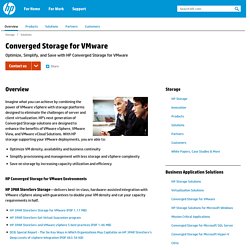
VMware vSphere: Storage - VMFS. VMware storage: SAN configuration basics. VMware storage entails more than simply mapping a logical unit number (LUN) to a physical server.
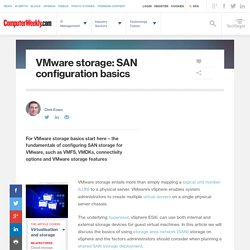
VMware’s vSphere enables system administrators to create multiple virtual servers on a single physical server chassis. The underlying hypervisor, vSphere ESXi, can use both internal and external storage devices for guest virtual machines. In this article we will discuss the basics of using storage area network (SAN) storage on vSphere and the factors administrators should consider when planning a shared SAN storage deployment. VMware storage: SAN basics vSphere supports internally-connected disks that include JBODs, hardware RAID arrays, solid-state disks and PCIe SSD cards.
SAN storage, however, provides a shared, highly available and resilient storage platform that can scale to a multi-server deployment. It is possible to use NAS and SAN-based storage products with vSphere, but in this article we will consider only SAN, or block-based devices. VMware vSphere Storage Appliance Documentation. VMware vSphere Storage Appliance (VSA) for Shared Storage. End of Availability VMware is announcing the End of Availability of all vSphere Storage Appliance versions, effective April 1, 2014.
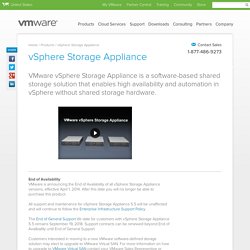
After this date you will no longer be able to purchase this product. All support and maintenance for vSphere Storage Appliance 5.5 will be unaffected and will continue to follow the Enterprise Infrastructure Support Policy. The End of General Support life date for customers with vSphere Storage Appliance 5.5 remains September 19, 2018. Support contracts can be renewed beyond End of Availbaility until End of General Support. Customers interested in moving to a new VMware software-defined storage solution may elect to upgrade to VMware Virtual SAN.